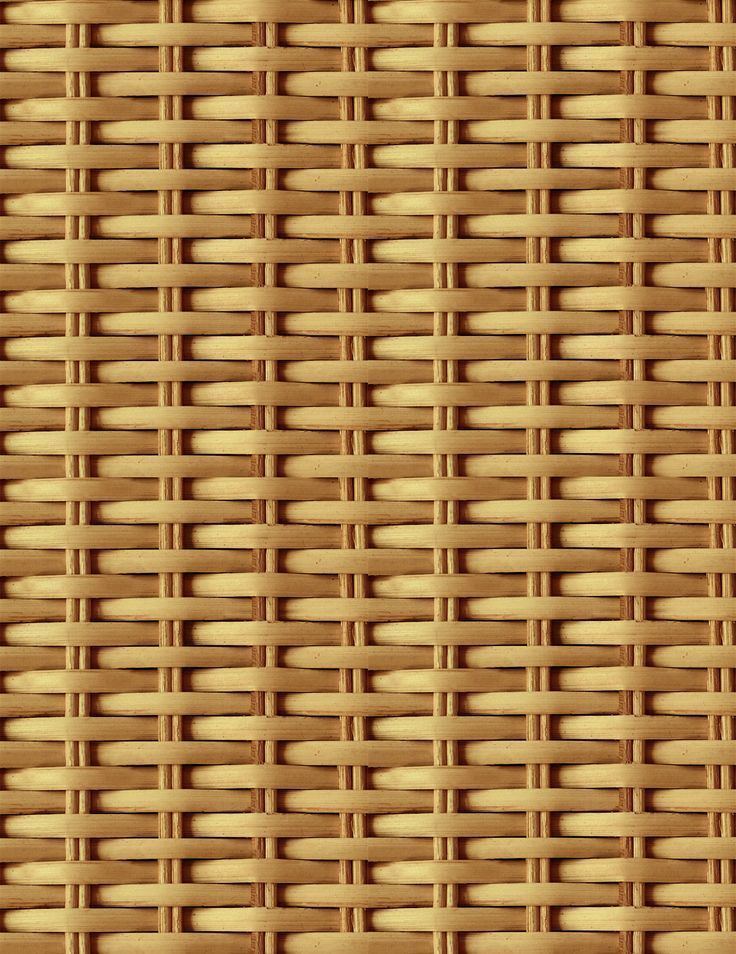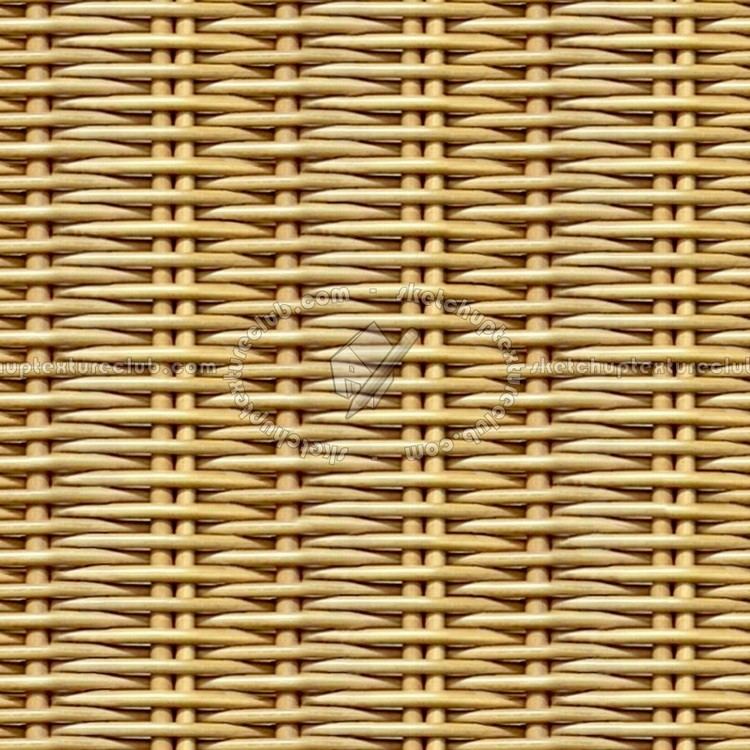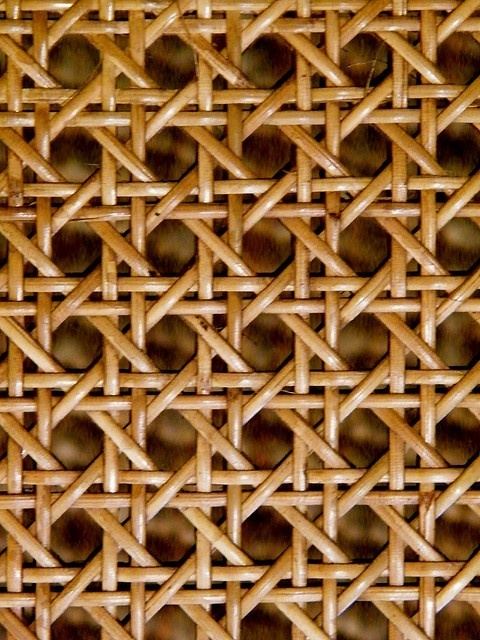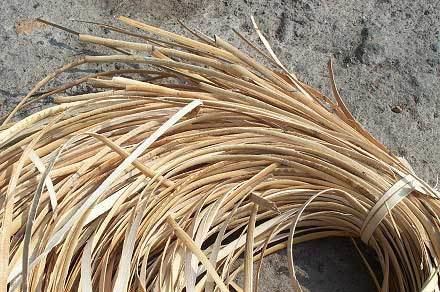Scientific name Calameae Rank Tribe | Higher classification Calamoideae | |
 | ||
Lower classifications Raffia palm, Salak, Metroxylon, Eremospatha, Metroxylon sagu | ||
Rattan (from the Malay rotan) is the name for roughly 600 species of old world climbing palms belonging to subfamily Calamoideae (from the Greek 'kálamos' = reed). Rattan is also known as manila, or malacca, named after the ports of shipment Manila and Malacca City, and as manau (from the Malay rotan manau, the trade name for Calamus manan canes in Southeast Asia). The climbing habit is associated with the characteristics of its flexible woody stem, derived typically from a secondary growth, makes rattan a liana rather than a true wood.
Contents
- Taxonomy
- Structure
- Economic and environmental issues
- Uses
- Furniture making
- Handicraft and arts
- Shelter material
- Food source and medicinal potential
- Corporal punishment
- Other uses
- References

Taxonomy

Calamoideae also includes tree palms such as Raphia (Raffia) and Metroxylon (Sago palm) and shrub palms such as Salacca (Salak) (Uhl & Dransfield 1987 Genera Palmarum). The climbing habit in palms is not restricted to Calamoideae, but has also evolved in three other evolutionary lines - Tribes Cocoeae (Desmoncus with c. 7-10 species in the New World tropics) and Areceae (Dypsis scandens in Madagascar) in subfamily Arecoideae, and Tribe Hyophorbeae (climbing species of the large genus Chamaedorea in Central America) in Subfamily Ceroxyloideae. They don't have spinose stems and climb by means of their reflexed terminal leaflets. Of these only Desmoncus spp. furnish stems of sufficiently good quality to be used as rattan cane substitutes.
There are 13 different genera of rattans that include around 600 species. Some of the species in these "rattan genera" have a different habit and do not climb, they are shrubby palms of the forest undergrowth; nevertheless they are close relatives to species that are climbers and they are hence included in the same genera. The largest rattan genus is Calamus, distributed in Asia except for one species represented in Africa. From the remaining rattan genera, Daemonorops, Ceratolobus, Korthalsia, Plectocomia, Plectocomiopsis, Myrialepis, Calospatha, Pogonotium and Retispatha, are centered in Southeast Asia with outliers eastwards and northwards; and three are endemic to Africa: Laccosperma (syn. Ancistrophyllum), Eremospatha and Oncocalamus.
The rattan genera and their distribution (Uhl & Dransfield 1987 Genera Palmarum, Dransfield 1992):

In Uhl & Dransfield (1987 Genera Palmarum, 2ºed. 2008), and also Dransfield & Manokaran (1993), a great deal of basic introductory information is available.
Available rattan floras and monographs by region (2002):
Uses by taxon.
The major commercial species of rattan canes as identified for Asia by Dransfield and Manokaran (1993) and for Africa, by Tuley (1995) and Sunderland (1999) (Desmoncus not treated here):
Utilized Calamus species canes:
Other traditional uses of rattans by species:
Structure
Most rattans differ from other palms in having slender stems, 2–5 cm diameter, with long internodes between the leaves; also, they are not trees but are vine-like lianas, scrambling through and over other vegetation. Rattans are also superficially similar to bamboo. Unlike bamboo, rattan stems ("malacca") are solid, and most species need structural support and cannot stand on their own. Many rattans have spines which act as hooks to aid climbing over other plants, and to deter herbivores. Rattans have been known to grow up to hundreds of metres long. Most (70%) of the world's rattan population exist in Indonesia, distributed among the islands Borneo, Sulawesi, and Sumbawa. The rest of the world's supply comes from the Philippines, Sri Lanka, Malaysia, and Bangladesh.
Economic and environmental issues
In forests where rattan grows, its economic value can help protect forest land, by providing an alternative to loggers who forgo timber logging and harvest rattan canes instead. Rattan is much easier to harvest, requires simpler tools and is much easier to transport. It also grows much faster than most tropical wood. This makes it a potential tool in forest maintenance, since it provides a profitable crop that depends on rather than replaces trees. It remains to be seen whether rattan can be as profitable or useful as the alternatives.
Rattans are threatened with overexploitation, as harvesters are cutting stems too young and reducing their ability to resprout. Unsustainable harvesting of rattan can lead to forest degradation, affecting overall forest ecosystem services. Processing can also be polluting. The use of toxic chemicals and petrol in the processing of rattan affects soil, air and water resources, and also ultimately people's health. Meanwhile, the conventional method of rattan production is threatening the plant's long-term supply, and the income of workers.
Uses
Generally, raw rattan is processed into several products to be used as materials in furniture making. The various species of rattan range from several millimetres up to 5–7 cm in diameter. From a strand of rattan, the skin is usually peeled off, to be used as rattan weaving material. The remaining "core" of the rattan can be used for various purposes in furniture making. Rattan is a very good material mainly because it is lightweight, durable, suitable for outdoor use, and—to a certain extent—flexible.
Furniture making
Rattans are extensively used for making furniture and baskets. When cut into sections, rattan can be used as wood to make furniture. Rattan accepts paints and stains like many other kinds of wood, so it is available in many colours; and it can be worked into many styles. Moreover, the inner core can be separated and worked into wicker.
Handicraft and arts
Many of the properties of rattan that make it suitable for furniture also make it a popular choice for handicraft and art pieces. Uses include rattan baskets, plant containers and other decorative works.
Due to its durability and resistance to splintering, sections of rattan can be used as staves or canes for martial arts—70 cm-long rattan sticks, called baston, are used in Filipino martial arts, especially Arnis/Eskrima/Kali and for the striking weapons in the Society for Creative Anachronism's full-contact "heavy combat".
Along with birch and bamboo, rattan is a common material used for the handles in percussion mallets, especially mallets for keyboard percussion (vibraphone, xylophone, marimba, etc.).
It is also used to make walking sticks and crooks for high-end umbrellas.
Shelter material
Most natives or locals from the rattan rich countries employ the aid of this sturdy plant in their home building projects. It is heavily used as a housing material in the rural areas. The skin of the plant or wood is primarily used for weaving.
Food source and medicinal potential
The fruit of some rattans exudes a red resin called dragon's blood. Some rattan fruits are edible, with a sour taste akin to citrus. This resin was thought to have medicinal properties in antiquity and was also used as a dye for violins, among other things. The resin normally results in a wood with a light peach hue. In the Indian state of Assam, the shoot is also used as vegetable.
Corporal punishment
Thin rattan canes were the standard implement for school corporal punishment in England and Wales, and are still used for this purpose in schools in Singapore, Malaysia and several African countries—and similar canes are used for military punishments in the Singapore Armed Forces,
Heavier canes, also of rattan, are used for judicial corporal punishments in Malaysia, Aceh, Singapore, and Brunei.
Other uses
Traditionally the women of the Wemale ethnic group of Seram Island, Indonesia wore rattan girdles around their waist.
In early 2010, scientists in Italy announced that rattan wood would be used in a new "wood to bone" process for the production of artificial bone. The process takes small pieces of rattan and places it in a furnace. Calcium and carbon are added. The wood is then further heated under intense pressure in another oven-like machine and a phosphate solution is introduced. This process produces almost an exact replica of bone material. The process takes about 10 days. At the time of the announcement the bone was being tested in sheep and there had been no signs of rejection. Particles from the sheep's bodies have migrated to the "wood bone" and formed long continuous bones. The new bone-from-wood programme is being funded by the European Union. Implants into humans are anticipated to start in 2015.
Rattan cane is also used traditionally to make polo mallets, though only a small portion of cane harvested (roughly 3%) is strong, flexible and durable enough to be made into sticks for polo mallets and rattan mallets are becoming decreasingly popular next the more modern variant, fibrecanes.
